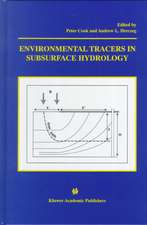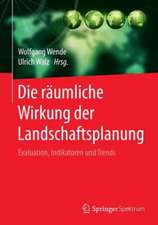Biodiversity Offsets: European Perspectives on No Net Loss of Biodiversity and Ecosystem Services
Editat de Wolfgang Wende, Graham - M. Tucker, Fabien Quétier, Matt Rayment, Marianne Darbien Limba Engleză Hardback – 16 mar 2018
Readers gain insights into current debates on biodiversity policies, with top experts outlining theoretical principles and the latest research findings. At the same time the focus is on practical application and case studies. Today there is a lively international discussion among practitioners and scientists on the optimal legal framework, metrics and design of habitat banks to ensure the success of biodiversity offsets and to minimise the risks of failure or misuse. Contributing to the debate, this volume presents the activities and practices of biodiversity offsetting already implemented in Europe in selected EU member states, and the lessons that can be learnt from them. Readers may be surprised at how much experience already exists in these countries. A further aim of the book is to offer grounded insights on the road ahead, and foster a more intensive and fruitful discussion on how offsetting can be extended and improved upon, so that it becomes a key and effective component of Europe’s biodiversity conservation policy framework.
| Toate formatele și edițiile | Preț | Express |
|---|---|---|
| Paperback (1) | 680.81 lei 3-5 săpt. | |
| Springer International Publishing – 19 dec 2018 | 680.81 lei 3-5 săpt. | |
| Hardback (1) | 929.86 lei 6-8 săpt. | |
| Springer International Publishing – 16 mar 2018 | 929.86 lei 6-8 săpt. |
Preț: 929.86 lei
Preț vechi: 1133.97 lei
-18% Nou
Puncte Express: 1395
Preț estimativ în valută:
178.01€ • 185.04$ • 147.59£
178.01€ • 185.04$ • 147.59£
Carte tipărită la comandă
Livrare economică 06-20 februarie 25
Preluare comenzi: 021 569.72.76
Specificații
ISBN-13: 9783319725796
ISBN-10: 3319725793
Pagini: 340
Ilustrații: XII, 252 p. 27 illus., 25 illus. in color.
Dimensiuni: 155 x 235 x 19 mm
Greutate: 0.55 kg
Ediția:1st ed. 2018
Editura: Springer International Publishing
Colecția Springer
Locul publicării:Cham, Switzerland
ISBN-10: 3319725793
Pagini: 340
Ilustrații: XII, 252 p. 27 illus., 25 illus. in color.
Dimensiuni: 155 x 235 x 19 mm
Greutate: 0.55 kg
Ediția:1st ed. 2018
Editura: Springer International Publishing
Colecția Springer
Locul publicării:Cham, Switzerland
Cuprins
Chapter 1: Introduction - Biodiversity Offsets: The European Perspective on No Net Loss of Biodiversity and Ecosystem Services.- Chapter 2: Introduction of a European Strategy on No Net Loss of Biodiversity.- Chapter 3: Principles of the Business and Biodiversity Offsets Programme.- Chapter 4: Austria.- Chapter 5: Belgium.- Chapter 6: The Czech Republic.- Chapter 7: France.- Chapter 8: Germany.- Chapter 9: Lithuania.- Chapter 10: Spain.- Chapter 11: The Netherlands.- Chapter 12: United Kingdom.- Chapter 13: Other EU Member States.- Chapter 14: Conclusions – Lessons from biodiversity offsetting experiences in Europe.
Recenzii
“This publication represents a first attempt to comprehensively review current practice related to biodiversity offsetting and compensation practices in Europe. … which will no doubt resonate with, and be directly useful to, the European conservation community. … Wolfgang et al. provide a useful synthesis on current practice and a valuable platform for further work.” (Laura J. Sonter, Biological Conservation, Vol. 225, September, 2018)
“The book deals with the compensation of impairments to biodiversity and ecosystem functions in Europe, by which means – and beyond the objectives of Natura 2000 – overall net loss can be reduced to practically zero (no net loss). … The book concludes by calling for an EU initiative to realise a biodiversity offsets scheme. It provides a very good overview of the range of existing approaches, while clearly showing that most MemberStates are still very much at a rudimentary stage.” (Translated from German by Derek Henderson, Dr. Frank Schalles, UVP-report, Vol. 32 (1), 2018)
“The book deals with the compensation of impairments to biodiversity and ecosystem functions in Europe, by which means – and beyond the objectives of Natura 2000 – overall net loss can be reduced to practically zero (no net loss). … The book concludes by calling for an EU initiative to realise a biodiversity offsets scheme. It provides a very good overview of the range of existing approaches, while clearly showing that most MemberStates are still very much at a rudimentary stage.” (Translated from German by Derek Henderson, Dr. Frank Schalles, UVP-report, Vol. 32 (1), 2018)
Notă biografică
Wolfgang WENDE is a landscape planner who has worked for the Technical University of Berlin and the Federal Environment Agency Germany. Since 2010 he has been a professor for urban development at the Technische Universität Dresden and head of the landscape research area at the Leibniz Institute of Ecological Urban and Regional Development (IOER), Dresden. He also has broad international experience, e.g. being a visiting professor at the National University of Singapore. For several years Wolfgang has promoted and supported biodiversity offsets, environmental impact assessment as well as landscape and urban planning tools emerging all over the world.
Graham TUCKER is an ecologist and environmental policy analyst, specializing in nature conservation policy issues in Europe. He has over 28 years’ professional experience, currently as head of the biodiversity programme at the Institute for European Environmental Policy and formerly as an environmental consultant and staffmember at the BirdLife International secretariat. In recent years he has developed a particular interest in the challenge of achieving no net loss of biodiversity and has carried out several studies for the European Commission on the subject.
Fabien QUÉTIER is the technical director on No Net Loss and Net Gain solutions for biodiversity at BIOTOPE. Through over a decade of interdisciplinary research on the vulnerability of biodiversity and ecosystem services to land-use change, he has acquired strong know-how in interfacing ecological knowledge and methods with socio-economic issues in support of decisions concerning natural resource and land-use management and policy. At BIOTOPE, he advises private and public decision makers on the implementation of the mitigation hierarchy to projects and programs, and in the design of biodiversity policies, worldwide. Fabien also carries out research on technical and organizational issues for biodiversity management, with a particular focus on mitigation and offsetting.
Matt RAYMENT is an environmental economist and independent consultant with more than 25 years’ experience in the evaluation and appraisal of public policy, and a particular interest in biodiversity. He has completed several studies on the design and implementation, costs and benefits of biodiversity offsets and no net loss initiatives, for the European Commission and UK government.
Marianne DARBI is a landscape planner, environmental scientist and consultant with long experience in the field of impact assessment and environmental compensation ("biodiversity offsets"), as well as planning and environmental research, biodiversity and ecosystems, the green economy and environmental markets ("habitat banks"). She is postdoctoral researcher at the Department of Conservation Biology at Helmholtz Centre for Environmental Research (UFZ), Leipzig. Marianne is working at the interface of science, policy and society in diverse contexts of nature and biodiversity conservation in Germany, the EU and internationally. In her Doctorate Thesis carried out at the Technische Universität Dresden and the Leibniz Institute of Ecological Urban and Regional Development she examined different types of voluntary biodiversity offsets.
Graham TUCKER is an ecologist and environmental policy analyst, specializing in nature conservation policy issues in Europe. He has over 28 years’ professional experience, currently as head of the biodiversity programme at the Institute for European Environmental Policy and formerly as an environmental consultant and staffmember at the BirdLife International secretariat. In recent years he has developed a particular interest in the challenge of achieving no net loss of biodiversity and has carried out several studies for the European Commission on the subject.
Fabien QUÉTIER is the technical director on No Net Loss and Net Gain solutions for biodiversity at BIOTOPE. Through over a decade of interdisciplinary research on the vulnerability of biodiversity and ecosystem services to land-use change, he has acquired strong know-how in interfacing ecological knowledge and methods with socio-economic issues in support of decisions concerning natural resource and land-use management and policy. At BIOTOPE, he advises private and public decision makers on the implementation of the mitigation hierarchy to projects and programs, and in the design of biodiversity policies, worldwide. Fabien also carries out research on technical and organizational issues for biodiversity management, with a particular focus on mitigation and offsetting.
Matt RAYMENT is an environmental economist and independent consultant with more than 25 years’ experience in the evaluation and appraisal of public policy, and a particular interest in biodiversity. He has completed several studies on the design and implementation, costs and benefits of biodiversity offsets and no net loss initiatives, for the European Commission and UK government.
Marianne DARBI is a landscape planner, environmental scientist and consultant with long experience in the field of impact assessment and environmental compensation ("biodiversity offsets"), as well as planning and environmental research, biodiversity and ecosystems, the green economy and environmental markets ("habitat banks"). She is postdoctoral researcher at the Department of Conservation Biology at Helmholtz Centre for Environmental Research (UFZ), Leipzig. Marianne is working at the interface of science, policy and society in diverse contexts of nature and biodiversity conservation in Germany, the EU and internationally. In her Doctorate Thesis carried out at the Technische Universität Dresden and the Leibniz Institute of Ecological Urban and Regional Development she examined different types of voluntary biodiversity offsets.
Textul de pe ultima copertă
This book deals with the new concept of biodiversity offsets. The aim of offsetting schemes is to achieve no let loss or even net gain of biodiversity. Offsets obey a mitigation hierarchy and reflect the precautionary and polluter-pays principle in regard to project impacts.
Readers gain insights into current debates on biodiversity policies, with top experts outlining theoretical principles and the latest research findings. At the same time the focus is on practical application and case studies. Today there is a lively international discussion among practitioners and scientists on the optimal legal framework, metrics and design of habitat banks to ensure the success of biodiversity offsets and to minimise the risks of failure or misuse. Contributing to the debate, this volume presents the activities and practices of biodiversity offsetting already implemented in Europe in selected EU member states, and the lessons that can be learnt from them. Readers may be surprised at how much experience already exists in these countries. A further aim of the book is to offer grounded insights on the road ahead, and foster a more intensive and fruitful discussion on how offsetting can be extended and improved upon, so that it becomes a key and effective component of Europe’s biodiversity conservation policy framework.
Readers gain insights into current debates on biodiversity policies, with top experts outlining theoretical principles and the latest research findings. At the same time the focus is on practical application and case studies. Today there is a lively international discussion among practitioners and scientists on the optimal legal framework, metrics and design of habitat banks to ensure the success of biodiversity offsets and to minimise the risks of failure or misuse. Contributing to the debate, this volume presents the activities and practices of biodiversity offsetting already implemented in Europe in selected EU member states, and the lessons that can be learnt from them. Readers may be surprised at how much experience already exists in these countries. A further aim of the book is to offer grounded insights on the road ahead, and foster a more intensive and fruitful discussion on how offsetting can be extended and improved upon, so that it becomes a key and effective component of Europe’s biodiversity conservation policy framework.
Caracteristici
Collates the work of over 30 international authors including top experts on biodiversity offsets Provides a comprehensive overview of the full range of offsetting principles in a series of european countries Each country chapter gives the respective legal background, methods adopted as well as case studies Discusses biodiversity research and policymaking as well as planning practice and teaching




























